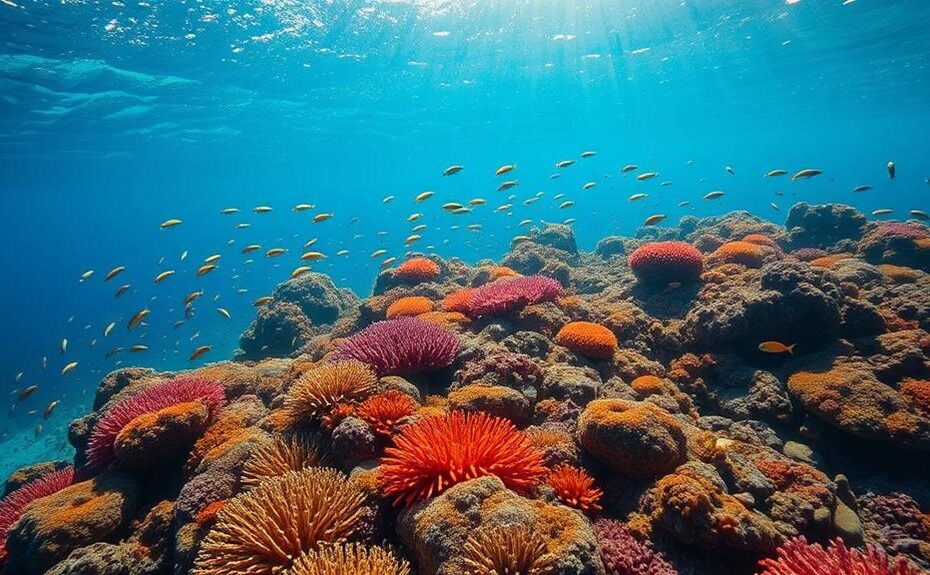Apo Reef is a prominent marine sanctuary in the Philippines, covering an area of approximately 7 km². It is home to an incredible array of marine life, with over 400 coral species and 615 fish species, including multiple shark varieties.
Established in 1982, the sanctuary has a no-take zone that promotes biodiversity and sustainable fishing. This conservation effort has led to the sanctuary's clear waters becoming a hotspot for divers.
Community engagement in management has been key to the development of effective conservation strategies, which not only enhance local livelihoods but also promote the overall health of the ecosystem.
Despite its success, Apo Reef faces challenges such as overfishing and climate change, which threaten the delicate balance of this ecosystem.
Understanding the dynamics of Apo Reef and its conservation efforts is crucial to appreciating its ecological importance, and invites further exploration into the measures taken to preserve it.
Geographic Location
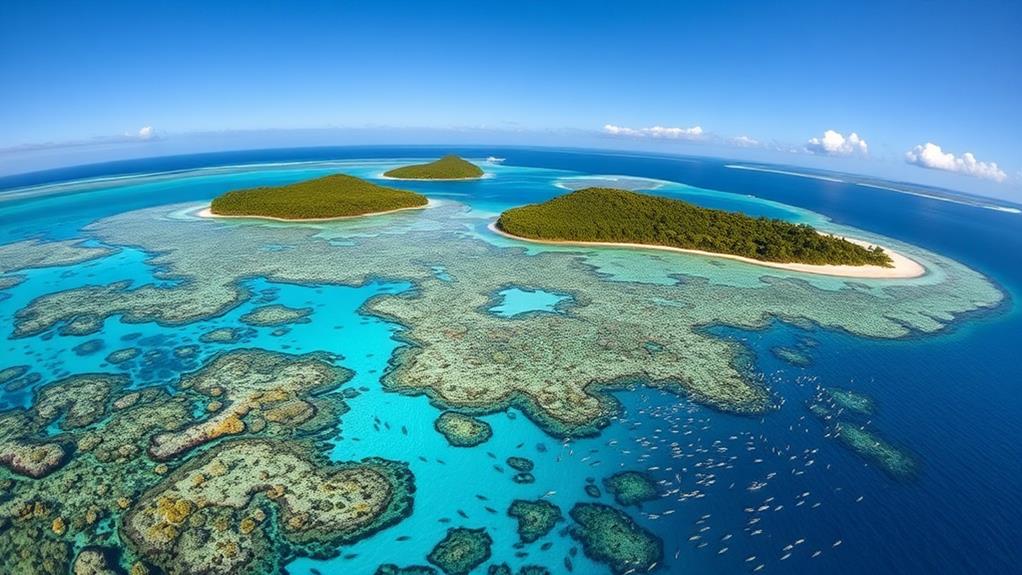
Apo Island is a key component of the Apo Island Marine Sanctuary, covering an area of approximately 7 km². This marine sanctuary is essential for preserving the diverse coral reefs and marine ecosystems surrounding the island.
Apo Island itself measures about 1 km² and is situated around 7 km off the southeast coast of Negros Oriental. It can be accessed via a 40-minute boat ride from Zamboanguita.
The fringing reef system within the sanctuary is exceptionally significant, housing around 400 of the approximately 450 coral species found in the Philippines. This high density of coral species contributes to the area's rich biodiversity, supporting a variety of marine life that thrives in these protected waters.
The clear, blue waters surrounding Apo Island serve two purposes: they enhance visibility for divers and play a critical role in sustaining the marine life that depends on these habitats for survival.
Historical Background
The establishment of the Apo Reef Marine Sanctuary in 1982 was a significant milestone in marine conservation efforts in the Philippines. Dr. Angel Alcala spearheaded this initiative to protect the region's rich marine biodiversity.
The local community played a crucial role in selecting a 450-meter shoreline area extending 500 meters from the shore for conservation efforts.
The Apo Reef Marine Sanctuary was recognized for its ecological significance under the National Integrated Protected Area Act (NIPA), which underscored its role in promoting sustainable fishing practices.
The sanctuary's success inspired the creation of hundreds of similar marine sanctuaries across the Philippines, amplifying national conservation efforts and enhancing marine biodiversity.
In 2023, the Marine Conservation Philippines provided guidance for the construction of Apo Jetty, reflecting an ongoing commitment to marine preservation and community involvement.
This collaborative approach strengthens the sanctuary's protective measures and fosters a sense of ownership among local stakeholders.
Marine Biodiversity
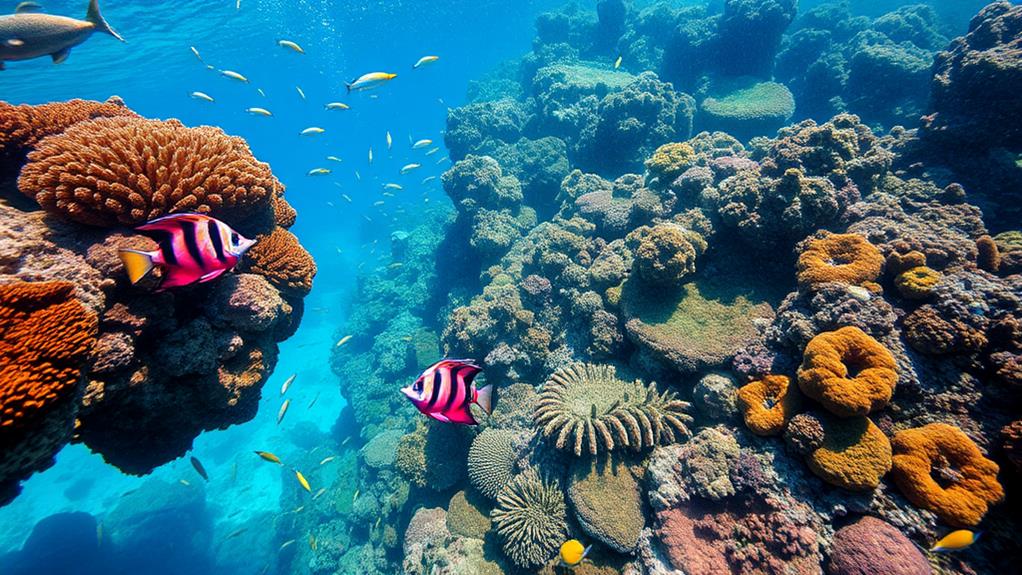
Apo Reef is a biodiverse marine ecosystem in the Philippines, boasting approximately 400 coral species and around 615 fish species. This remarkable biodiversity is crucial for maintaining ecological balance and supporting a vibrant marine life.
The reef features an impressive array of fish species, with approximately 385 species from 85 families. These species include damsel fishes, wrasses, and groupers, among others.
The diverse invertebrate population, including starfishes, sea urchins, nudibranchs, and octopus, contributes significantly to the ecological richness of Apo Reef.
The clear visibility in the waters enhances the exploration of the vibrant marine life. This makes Apo Reef a prime destination for divers and marine enthusiasts.
The interplay between coral species and fish species fosters a dynamic ecosystem that not only attracts visitors but also plays a vital role in conservation efforts.
By exploring Apo Reef's marine biodiversity, you're witnessing the interconnectedness of life beneath the waves, emphasizing the importance of preserving such unique habitats.
Fish Species Overview
Apo Reef is home to an impressive 385 fish species from 85 families.
This remarkable diversity is primarily found within the protected marine sanctuary, where the health of coral reefs plays a crucial role in sustaining various fish populations. Key species include damsel fishes, wrasses, butterfly fishes, groupers, gobies, angel fishes, blennies, and parrot fishes, each contributing to the vibrant ecosystem.
Sharks are also present in the sanctuary, with species like white tip, black tip, hammerhead, and gray sharks inhabiting deeper waters.
The establishment of the marine sanctuary has led to a significant increase in fish numbers, with an eight-fold rise reported. This demonstrates the effectiveness of conservation practices in protecting and promoting marine life.
Apo Reef's thriving ecosystem supports the maturation of various fish species and allows them to migrate outside the sanctuary.
This, in turn, provides a sustainable resource for the local fishing community. The sanctuary serves as a vital example of how marine sanctuaries can enhance biodiversity and promote the health of both marine life and local economies.
Invertebrate Life
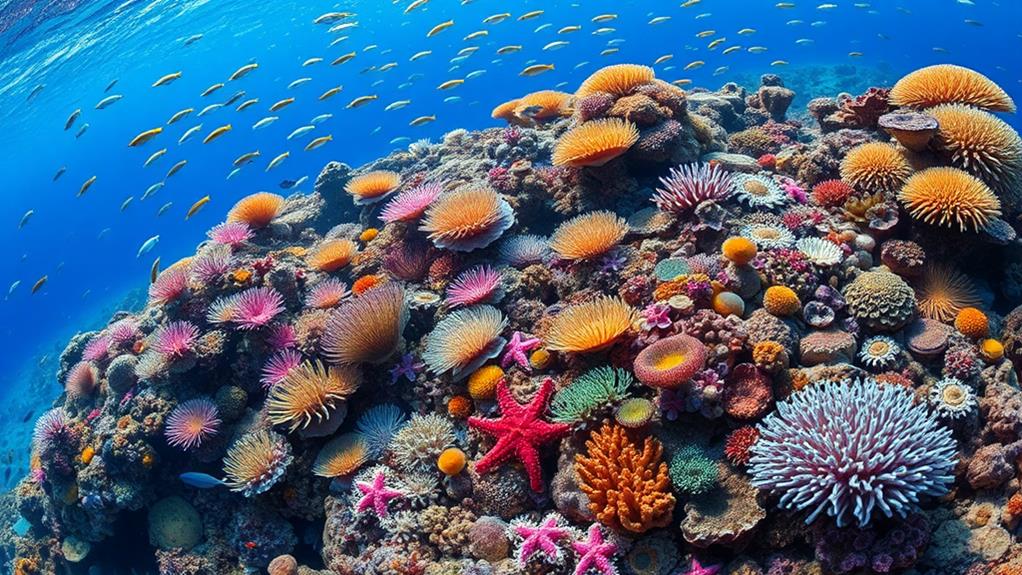
Apo Reef's invertebrate life is incredibly diverse and plays a crucial role in maintaining the health of its marine ecosystem.
Invertebrates like holothurians, or sea cucumbers, are essential for nutrient cycling. They recycle organic matter, improving sediment quality and promoting coral health.
Sea urchins and brittle stars are also abundant and vital for maintaining the balance of the coral reef ecosystem.
The reef is home to a wide variety of sponges, sea squirts, worms, snails, and nudibranchs, demonstrating the complexity of invertebrate life. Notable invertebrates like octopus, clams, squid, and giant clams contribute to biodiversity and influence ecosystem dynamics by serving as prey and participating in nutrient cycling.
Unique species like the coconut crab and rare shell species highlight the ecological richness of Apo Reef. Protecting these invertebrates is crucial for maintaining ecological balance and ensuring the health of this vibrant marine sanctuary.
Conservation Efforts
The Apo Reef Natural Park is a vital no-take zone that safeguards marine biodiversity. This protected area is home to over 615 fish species and approximately 400 coral species, making it a significant contributor to the region's ecosystem.
Conservation efforts in Apo Reef were initiated by Silliman University researchers. These efforts led to the establishment of the Apo Island Marine Sanctuary in 1982, which has since inspired the creation of hundreds of marine sanctuaries throughout the Philippines.
Local fishermen play a crucial role in managing the Apo Island Marine Sanctuary. Through the Marine Management Committee, they ensure sustainable fishing practices and strict enforcement of regulations.
As a result, fish populations have increased eight-fold since the sanctuary's inception, demonstrating the effectiveness of conservation measures in promoting healthy ecosystems and supporting local livelihoods.
The sanctuary also protects vital nursery areas for coral ecosystems. It educates local communities about population control and environmental impact, fostering ongoing support for conservation initiatives.
This has ensured that marine biodiversity continues to thrive in the Apo Reef region.
Tourism and Ecotourism
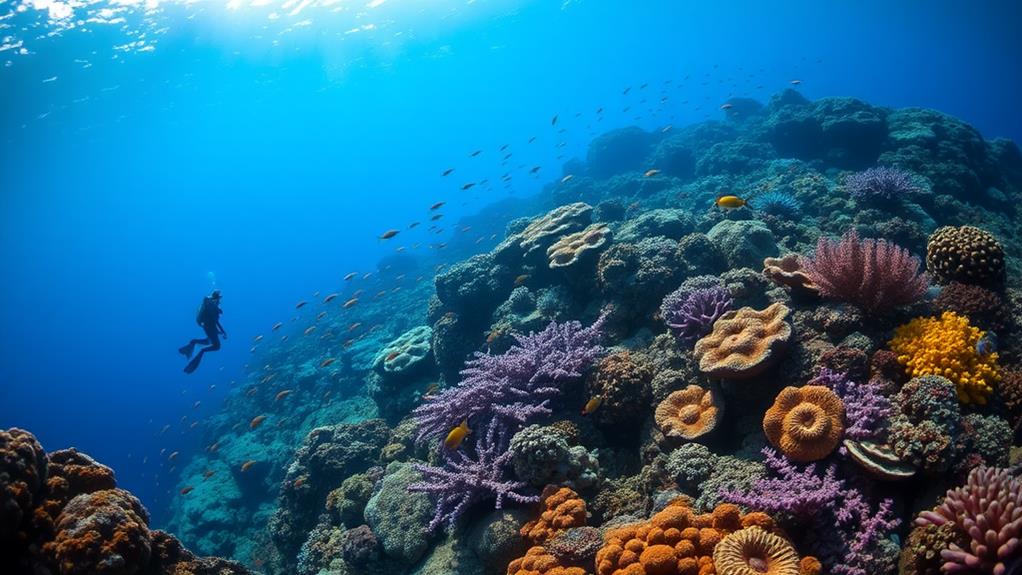
Apo Reef's rich biodiversity, featuring over 615 fish species and 400 coral species, makes it a premier destination for divers and marine enthusiasts. This biodiversity attracts tourists and promotes sustainable tourism practices to protect the delicate marine ecosystem.
Sustainable tourism practices minimize ecological stress while raising awareness of biodiversity. For instance, initiatives educate tourists about the importance of not touching or standing on coral reefs, which helps prevent damage to the ecosystem.
Tourism generates revenue that supports local livelihoods and park maintenance through ecotourism activities. Boat tours and diving excursions are examples of ecotourism activities that contribute to the local economy. This revenue helps maintain the park's infrastructure and supports the livelihoods of local communities.
Small resorts and accommodations have emerged to enhance the local economy. However, this development also raises concerns over sewage management. It's essential to ensure that these infrastructure developments don't harm the environment.
Diving restrictions are in place to protect fishing grounds. These restrictions ensure that tourism doesn't conflict with local fishing practices. By protecting fishing grounds, the local fishing communities can continue to thrive.
Community Engagement
Community Engagement: Key to Sustainable Management
Community engagement is essential for the sustainable management of Apo Reef Marine Sanctuary. Local communities, especially those in Sablayan, actively participate in this initiative, collaborating with the local government to transition from traditional fishing to sustainable livelihoods. This shift not only benefits the environment but also enhances the local economy.
Eco-tourism initiatives promote conservation efforts. Boat tours and diving activities are promoted to involve the community in conservation efforts. These activities generate revenue through user fees, which directly support park maintenance and conservation projects. Strict regulations ensure ecologically friendly tourism practices, safeguarding the marine sanctuary while providing economic opportunities for residents.
Education programs foster a sense of responsibility. Community education programs emphasize the importance of population control and environmental impact, fostering a collective sense of responsibility towards preserving the marine ecosystem.
By involving local fishermen in sanctuary management, successful conservation strategies have emerged, reducing reliance on external interventions. This local stewardship enhances the protection of marine resources and promotes sustainable practices.
Community engagement is crucial for the sanctuary's health. Ultimately, community engagement isn't just beneficial; it's essential for the lasting health and viability of Apo Reef Marine Sanctuary, creating a model for sustainable interaction between communities and their natural environment.
Environmental Challenges
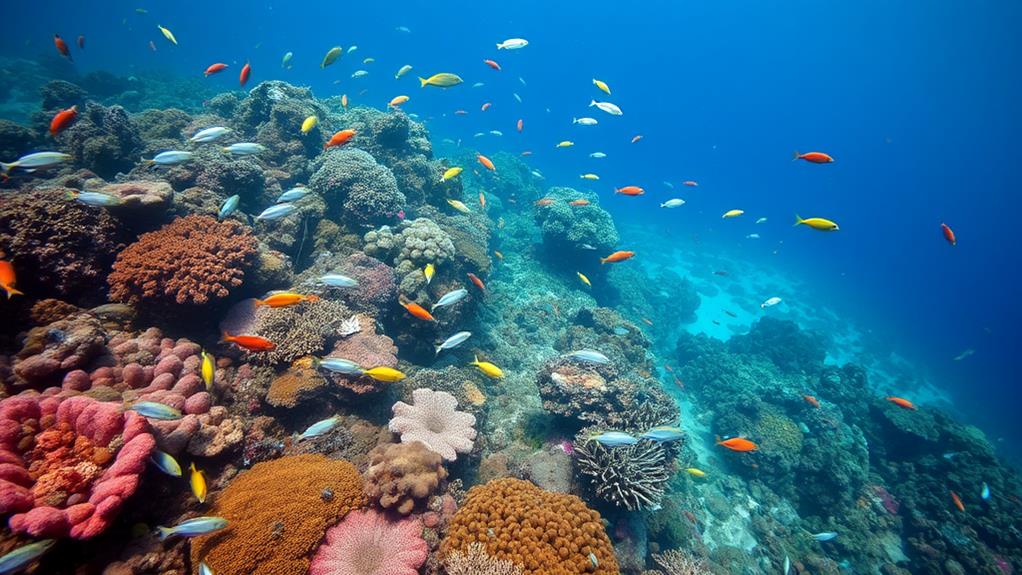
Apo Reef Marine Sanctuary faces significant threats from human activities and climate change, jeopardizing its delicate ecosystem balance.
Overfishing is a major concern, as unsustainable fishing practices deplete fish populations, disrupting the natural food chain. For example, certain fishing gear can catch non-target species, including endangered ones, and damage habitats.
Destructive Coral Mining also harms the reef. This practice not only damages coral habitats but also diminishes marine biodiversity. Coral mining can lead to the destruction of entire coral colonies, causing long-term damage to the ecosystem.
Chemical Pollution is another significant threat. Runoff from nearby human activities introduces harmful substances that degrade water quality and coral health. For instance, fertilizers from farms can increase algae growth, which can outcompete coral for space and resources.
Climate Change poses a significant threat to the reef. Rising ocean temperatures and acidification contribute to coral bleaching, jeopardizing the survival of coral species. Warmer waters can cause corals to expel their algal symbionts, turning white and often leading to coral death.
To address these challenges, the government has implemented conservation measures, including the establishment of designated conservation zones. These zones aim to mitigate human impact and promote recovery.
By prioritizing these strategies, we can enhance marine biodiversity and restore the health of coral habitats. However, effective collaboration between stakeholders, including local communities, researchers, and policymakers, is crucial to ensure the success of these efforts.
Without immediate action, Apo Reef risks losing its vibrant ecosystem, which plays a vital role in sustaining marine life.
Questions and Answers
What Species Are in the Apo Reef?
Apo Reef is home to approximately 385 fish species, including groupers and wrasses.
This remarkable diversity is accompanied by 400 types of coral, making the reef a significant hub for marine biodiversity.
The reef's ecological importance is underscored by its rich species variety, which is essential for conservation efforts.
Why Is Apo Reef Famous?
Apo Reef's fame stems from its status as a biodiversity hotspot. This reputation attracts marine enthusiasts worldwide due to its exceptional vibrant coral ecosystems and diverse marine life, offering stunning underwater photography opportunities.
As a sanctuary committed to marine conservation, Apo Reef provides thriving habitats for endangered species, making it an ideal location for snorkeling adventures.
Its rich biodiversity and successful conservation efforts have established Apo Reef as a premier destination for both education and recreation in marine environments.
Where Is Apo Island Marine Sanctuary Located?
Apo Island Marine Sanctuary is located about 7 km from the southeastern coast of Negros Oriental in the Philippines.
This location is significant because it serves as a vital marine conservation site, known for its rich biodiversity hotspot.
The sanctuary is renowned for its incredible diving spots, which attract tourists and researchers alike.
What Is the Problem With the Apo Reef?
Apo Reef faces multiple threats to its ecosystem.
The coral bleaching issue stems from climate change, which stresses the coral and disrupts marine life. For instance, rising water temperatures cause coral to expel algae, turning white and often leading to coral death.
Overfishing disrupts the delicate balance within the reef. When too many fish are removed, it affects the food chain and the entire ecosystem. For example, if too many herbivorous fish are caught, algae growth can get out of control, harming the coral.
Tourism pressures strain resources and complicate conservation efforts. The increasing number of visitors puts pressure on local resources, such as water and energy. Moreover, tourist activities like snorkeling and diving can damage the reef if not done sustainably.
Increased human activity raises concerns about pollution and habitat degradation. Pollution from human activities, such as agricultural runoff and sewage, can harm marine life.
Habitat degradation, like the destruction of coral reefs, can also occur due to human carelessness.
A coordinated approach is necessary to protect Apo Reef effectively. Addressing these issues requires a joint effort from the government, conservationists, and local communities to implement sustainable practices and protect this vital marine environment.
